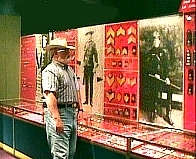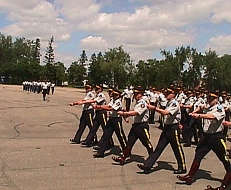The Royal
Canadian Mounted Police
Training Depot
Regina, Saskatchewan
July 21, 2000
Any  trip to Regina, the provincial capital of
Saskatchewan should include a tour of The Royal Canadian Mounted
Police Depot, or training academy. In my 32 years of law
enforcement, training academies were nothing unusual, but here
was the famous, often described, center for the training of
Canada's heroes. Those soldiers in red, often pictured riding off
into the sunset to save a damsel in distress, or to dash some
criminal's hope of stealing all the gold, as depicted on many a
silver screen in the American Pictures of mid '50s. "The
Mounty always got his man". Off the screen, the RCMP, as it
is referred to now in Canada, is a vibrant full service national
police force made up of over 20 divisions with a total strength
in the thousands.
trip to Regina, the provincial capital of
Saskatchewan should include a tour of The Royal Canadian Mounted
Police Depot, or training academy. In my 32 years of law
enforcement, training academies were nothing unusual, but here
was the famous, often described, center for the training of
Canada's heroes. Those soldiers in red, often pictured riding off
into the sunset to save a damsel in distress, or to dash some
criminal's hope of stealing all the gold, as depicted on many a
silver screen in the American Pictures of mid '50s. "The
Mounty always got his man". Off the screen, the RCMP, as it
is referred to now in Canada, is a vibrant full service national
police force made up of over 20 divisions with a total strength
in the thousands.  They
are contracted by all the territories and all but two Provinces
for provincial police service, something akin to State Police in
the U.S. Ontario and Quebec being large enough to provide their
own Provincial Police. In addition, many towns throughout Canada
privately contract with the RCMP for police protection. The RCMP
takes full advantage of its colorful image and goes to great
effort to afford an opportunity to the public to see the Depot in
action. The center point of this opportunity is the RCMP Museum
on the east side of the parade field.
They
are contracted by all the territories and all but two Provinces
for provincial police service, something akin to State Police in
the U.S. Ontario and Quebec being large enough to provide their
own Provincial Police. In addition, many towns throughout Canada
privately contract with the RCMP for police protection. The RCMP
takes full advantage of its colorful image and goes to great
effort to afford an opportunity to the public to see the Depot in
action. The center point of this opportunity is the RCMP Museum
on the east side of the parade field.  Here the epic story of the RCMP unfolds in
picture and artifacts. From the desperate original writings of
Inspector Fitzgerald of the lost patrol, to the suppression of
the Great Canadian Rebellion, the work of the Mounties is laid
out in a wandering maze of glass cases and free standing
displays. The small theater seating only a few dozen, shows films
on the history of the organization as well as a great film on the
famous "Musical Dance" which is performed by the
mounted honor guard, most familiar as a symbol of the RCMP, seen
around the world. The red-coated Mounties on huge black horses.
From here we went to the parade
Here the epic story of the RCMP unfolds in
picture and artifacts. From the desperate original writings of
Inspector Fitzgerald of the lost patrol, to the suppression of
the Great Canadian Rebellion, the work of the Mounties is laid
out in a wandering maze of glass cases and free standing
displays. The small theater seating only a few dozen, shows films
on the history of the organization as well as a great film on the
famous "Musical Dance" which is performed by the
mounted honor guard, most familiar as a symbol of the RCMP, seen
around the world. The red-coated Mounties on huge black horses.
From here we went to the parade  ground for the Friday afternoon Sergeant Major's
parade. The Academy is made up of over 50 buildings situated on
740 acres of land. It generally houses some 600 cadets for the 22
week basic training course plus any number of non-RCMP officers
taking special training offered at the Academy. Today's parade
consisted of 4 platoons of 26 cadets each, led onto the field by
a talented band, which included a lone piper. The inspection and
march was very crisp and military-like. In precision movements,
with swinging arms, the platoons moved about
ground for the Friday afternoon Sergeant Major's
parade. The Academy is made up of over 50 buildings situated on
740 acres of land. It generally houses some 600 cadets for the 22
week basic training course plus any number of non-RCMP officers
taking special training offered at the Academy. Today's parade
consisted of 4 platoons of 26 cadets each, led onto the field by
a talented band, which included a lone piper. The inspection and
march was very crisp and military-like. In precision movements,
with swinging arms, the platoons moved about  for their
inspection. Each move or turn was executed with a high stepping
snap of the right leg by the inspector in motion. It was
reminiscent of old movies of the British Army on parade. As is
the case the RCMP is very British. From the famous red fringe
tunics to their marching order, they are British through and
through. After the parade, we joined a tour given by a local
university student working a summer job. This took us into the
Academy itself. Next to the museum stands the original chapel
which has served the non-denominational religious needs of the
Depot since its creation. Inscribed along the walls are the
names and circumstances of those who died in the line of duty. In
the front of the chapel flanked on either side of the alter are
two large stain glass windows depicting the past and future of
the
for their
inspection. Each move or turn was executed with a high stepping
snap of the right leg by the inspector in motion. It was
reminiscent of old movies of the British Army on parade. As is
the case the RCMP is very British. From the famous red fringe
tunics to their marching order, they are British through and
through. After the parade, we joined a tour given by a local
university student working a summer job. This took us into the
Academy itself. Next to the museum stands the original chapel
which has served the non-denominational religious needs of the
Depot since its creation. Inscribed along the walls are the
names and circumstances of those who died in the line of duty. In
the front of the chapel flanked on either side of the alter are
two large stain glass windows depicting the past and future of
the  RCMP.
The chapel is still in use today and any deceased, retired
Mountie has the right to a funeral service there. One was
actually scheduled for later in the afternoon, as we watched
cadets mastering their martial arts or practicing the drill. As
we prepared to depart, I found myself leaning against the front
desk chatting with an old retired Mountie with a gruff Scottish
brogue. I asked him what he thought would be equivalent to the
Mounties in the U.S. He smiled, thought for a moment and then
said "FBI agents with ticket books." Having known many
an agent for our FBI, the image I conjured up of one of them
making a traffic stop was most amusing.
RCMP.
The chapel is still in use today and any deceased, retired
Mountie has the right to a funeral service there. One was
actually scheduled for later in the afternoon, as we watched
cadets mastering their martial arts or practicing the drill. As
we prepared to depart, I found myself leaning against the front
desk chatting with an old retired Mountie with a gruff Scottish
brogue. I asked him what he thought would be equivalent to the
Mounties in the U.S. He smiled, thought for a moment and then
said "FBI agents with ticket books." Having known many
an agent for our FBI, the image I conjured up of one of them
making a traffic stop was most amusing.
*** THE END ***

 trip to Regina, the provincial capital of
Saskatchewan should include a tour of The Royal Canadian Mounted
Police Depot, or training academy. In my 32 years of law
enforcement, training academies were nothing unusual, but here
was the famous, often described, center for the training of
Canada's heroes. Those soldiers in red, often pictured riding off
into the sunset to save a damsel in distress, or to dash some
criminal's hope of stealing all the gold, as depicted on many a
silver screen in the American Pictures of mid '50s. "The
Mounty always got his man". Off the screen, the RCMP, as it
is referred to now in Canada, is a vibrant full service national
police force made up of over 20 divisions with a total strength
in the thousands.
trip to Regina, the provincial capital of
Saskatchewan should include a tour of The Royal Canadian Mounted
Police Depot, or training academy. In my 32 years of law
enforcement, training academies were nothing unusual, but here
was the famous, often described, center for the training of
Canada's heroes. Those soldiers in red, often pictured riding off
into the sunset to save a damsel in distress, or to dash some
criminal's hope of stealing all the gold, as depicted on many a
silver screen in the American Pictures of mid '50s. "The
Mounty always got his man". Off the screen, the RCMP, as it
is referred to now in Canada, is a vibrant full service national
police force made up of over 20 divisions with a total strength
in the thousands.  They
are contracted by all the territories and all but two Provinces
for provincial police service, something akin to State Police in
the U.S. Ontario and Quebec being large enough to provide their
own Provincial Police. In addition, many towns throughout Canada
privately contract with the RCMP for police protection. The RCMP
takes full advantage of its colorful image and goes to great
effort to afford an opportunity to the public to see the Depot in
action. The center point of this opportunity is the RCMP Museum
on the east side of the parade field.
They
are contracted by all the territories and all but two Provinces
for provincial police service, something akin to State Police in
the U.S. Ontario and Quebec being large enough to provide their
own Provincial Police. In addition, many towns throughout Canada
privately contract with the RCMP for police protection. The RCMP
takes full advantage of its colorful image and goes to great
effort to afford an opportunity to the public to see the Depot in
action. The center point of this opportunity is the RCMP Museum
on the east side of the parade field.  Here the epic story of the RCMP unfolds in
picture and artifacts. From the desperate original writings of
Inspector Fitzgerald of the lost patrol, to the suppression of
the Great Canadian Rebellion, the work of the Mounties is laid
out in a wandering maze of glass cases and free standing
displays. The small theater seating only a few dozen, shows films
on the history of the organization as well as a great film on the
famous "Musical Dance" which is performed by the
mounted honor guard, most familiar as a symbol of the RCMP, seen
around the world. The red-coated Mounties on huge black horses.
From here we went to the parade
Here the epic story of the RCMP unfolds in
picture and artifacts. From the desperate original writings of
Inspector Fitzgerald of the lost patrol, to the suppression of
the Great Canadian Rebellion, the work of the Mounties is laid
out in a wandering maze of glass cases and free standing
displays. The small theater seating only a few dozen, shows films
on the history of the organization as well as a great film on the
famous "Musical Dance" which is performed by the
mounted honor guard, most familiar as a symbol of the RCMP, seen
around the world. The red-coated Mounties on huge black horses.
From here we went to the parade  ground for the Friday afternoon Sergeant Major's
parade. The Academy is made up of over 50 buildings situated on
740 acres of land. It generally houses some 600 cadets for the 22
week basic training course plus any number of non-RCMP officers
taking special training offered at the Academy. Today's parade
consisted of 4 platoons of 26 cadets each, led onto the field by
a talented band, which included a lone piper. The inspection and
march was very crisp and military-like. In precision movements,
with swinging arms, the platoons moved about
ground for the Friday afternoon Sergeant Major's
parade. The Academy is made up of over 50 buildings situated on
740 acres of land. It generally houses some 600 cadets for the 22
week basic training course plus any number of non-RCMP officers
taking special training offered at the Academy. Today's parade
consisted of 4 platoons of 26 cadets each, led onto the field by
a talented band, which included a lone piper. The inspection and
march was very crisp and military-like. In precision movements,
with swinging arms, the platoons moved about  for their
inspection. Each move or turn was executed with a high stepping
snap of the right leg by the inspector in motion. It was
reminiscent of old movies of the British Army on parade. As is
the case the RCMP is very British. From the famous red fringe
tunics to their marching order, they are British through and
through. After the parade, we joined a tour given by a local
university student working a summer job. This took us into the
Academy itself. Next to the museum stands the original chapel
which has served the non-denominational religious needs of the
Depot since its creation. Inscribed along the walls are the
names and circumstances of those who died in the line of duty. In
the front of the chapel flanked on either side of the alter are
two large stain glass windows depicting the past and future of
the
for their
inspection. Each move or turn was executed with a high stepping
snap of the right leg by the inspector in motion. It was
reminiscent of old movies of the British Army on parade. As is
the case the RCMP is very British. From the famous red fringe
tunics to their marching order, they are British through and
through. After the parade, we joined a tour given by a local
university student working a summer job. This took us into the
Academy itself. Next to the museum stands the original chapel
which has served the non-denominational religious needs of the
Depot since its creation. Inscribed along the walls are the
names and circumstances of those who died in the line of duty. In
the front of the chapel flanked on either side of the alter are
two large stain glass windows depicting the past and future of
the  RCMP.
The chapel is still in use today and any deceased, retired
Mountie has the right to a funeral service there. One was
actually scheduled for later in the afternoon, as we watched
cadets mastering their martial arts or practicing the drill. As
we prepared to depart, I found myself leaning against the front
desk chatting with an old retired Mountie with a gruff Scottish
brogue. I asked him what he thought would be equivalent to the
Mounties in the U.S. He smiled, thought for a moment and then
said "FBI agents with ticket books." Having known many
an agent for our FBI, the image I conjured up of one of them
making a traffic stop was most amusing.
RCMP.
The chapel is still in use today and any deceased, retired
Mountie has the right to a funeral service there. One was
actually scheduled for later in the afternoon, as we watched
cadets mastering their martial arts or practicing the drill. As
we prepared to depart, I found myself leaning against the front
desk chatting with an old retired Mountie with a gruff Scottish
brogue. I asked him what he thought would be equivalent to the
Mounties in the U.S. He smiled, thought for a moment and then
said "FBI agents with ticket books." Having known many
an agent for our FBI, the image I conjured up of one of them
making a traffic stop was most amusing. 